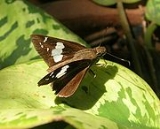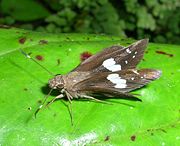
Notocrypta curvifascia
Encyclopedia
Notocrypta curvifascia, commonly known as the Restricted Demon, is a butterfly
belonging to the family Hesperiidae. N. curvifascia is commonly found in many regions of temperate and tropical East Asia
, Indonesia
, and the Indian subcontinent
, wherever its preferred larval host plant, Alpinia speciosa
can be found.
 Among butterflies, it is relatively small, at approximately 4 cm long (adult). Its wings are dark brown to black, with a white eyespot
Among butterflies, it is relatively small, at approximately 4 cm long (adult). Its wings are dark brown to black, with a white eyespot
near the trailing end.

The larval host plants include members of the Zingiberaceae
and Musaceae
such as Alpinia japonica, Alpinia zerumbet
, Curcuma decipiens, Costus speciosus
, Curcuma longa, Globba marantina, Musa acuminata × balbisiana
, Zingiber casumunar, Zingiber odoriferum, Zingiber officinale. Other plants include Hedychium
spp. and Zingiber zerumbet
.
Butterfly
A butterfly is a mainly day-flying insect of the order Lepidoptera, which includes the butterflies and moths. Like other holometabolous insects, the butterfly's life cycle consists of four parts: egg, larva, pupa and adult. Most species are diurnal. Butterflies have large, often brightly coloured...
belonging to the family Hesperiidae. N. curvifascia is commonly found in many regions of temperate and tropical East Asia
East Asia
East Asia or Eastern Asia is a subregion of Asia that can be defined in either geographical or cultural terms...
, Indonesia
Indonesia
Indonesia , officially the Republic of Indonesia , is a country in Southeast Asia and Oceania. Indonesia is an archipelago comprising approximately 13,000 islands. It has 33 provinces with over 238 million people, and is the world's fourth most populous country. Indonesia is a republic, with an...
, and the Indian subcontinent
Indian subcontinent
The Indian subcontinent, also Indian Subcontinent, Indo-Pak Subcontinent or South Asian Subcontinent is a region of the Asian continent on the Indian tectonic plate from the Hindu Kush or Hindu Koh, Himalayas and including the Kuen Lun and Karakoram ranges, forming a land mass which extends...
, wherever its preferred larval host plant, Alpinia speciosa
Alpinia
Alpinia is a genus of plants, with more than 230 species from the Ginger family . It is named for Prospero Alpini, a 17th-century Italian botanist who specialized in exotic plants.-Description:...
can be found.

Eyespot (mimicry)
An eyespot is an eye-like marking. They are found on butterflies, reptiles, birds and fish. In members of the Felidae family , the white circular markings on the backs of the ears are termed ocelli, and they are functionally similar to eyespots in other animals.Eyespots may be a form of...
near the trailing end.
Host plants

The larval host plants include members of the Zingiberaceae
Zingiberaceae
Zingiberaceae, or the Ginger family, is a family of flowering plants consisting of aromatic perennial herbs with creeping horizontal or tuberous rhizomes, comprising ca. 52 genera and more than 1300 species, distributed throughout tropical Africa, Asia, and the Americas.Many species are important...
and Musaceae
Musaceae
Musaceae is a botanical name for a family of flowering plants. The family is native to the tropics of Africa and Asia. The plants have a large herbaceous growth habit with leaves with overlapping basal sheaths that form a pseudostem making some members appear to be woody trees.The family has been...
such as Alpinia japonica, Alpinia zerumbet
Alpinia zerumbet
Alpinia zerumbet is a Chinese perennial plant of the ginger family ....
, Curcuma decipiens, Costus speciosus
Costus speciosus
Costus speciosus or Cheilocostus speciosus or crape ginger is possibly the best known cultivated species of the genus Costus. This plant is native to southeast Asia, especially on the Greater Sunda Islands in Indonesia...
, Curcuma longa, Globba marantina, Musa acuminata × balbisiana
Plantain
Plantain is the common name for herbaceous plants of the genus Musa. The fruit they produce is generally used for cooking, in contrast to the soft, sweet banana...
, Zingiber casumunar, Zingiber odoriferum, Zingiber officinale. Other plants include Hedychium
Hedychium
Hedychium is a genus of perennial plants native to tropical Asia and the Himalayas, commonly growing to between 120 and 180 cm tall. Common names include garland flower, ginger lily, and kahili ginger...
spp. and Zingiber zerumbet
Zingiber zerumbet
Zingiber zerumbet Sm., also known as the Shampoo Ginger, is a vigorous ginger with leafy stems growing to about 1.2 m tall. It is found in many tropical countries. The rhizomes of Z...
.

